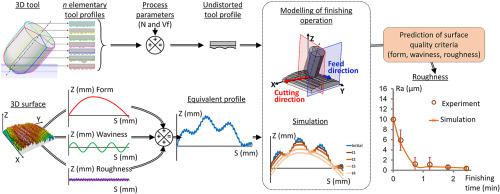International Journal of Machine Tools and Manufacture ( IF 14.0 ) Pub Date : 2021-02-11 , DOI: 10.1016/j.ijmachtools.2021.103704 Julien Chaves-Jacob , Anthony Beaucamp , Wule Zhu , Daisuke Kono , Jean-Marc Linares

|
Surface finishing with compliant tools is a widely used technology that still relies heavily on the trial-and-error approach. To predict surface evolution, one should ideally consider the tool as a set of grains and take into account the cutting action of each grain. In practice, the small size of abrasives renders this approach unpractical for industrial application. In this paper, the various aspects playing a role in surface generation, from micro-scale abrasives to macro-scale tool deformation as well as the time-dependent nature of compliant processes, are rationalized and modelled in a Folding Space (FS) rather than a classic geometrical space. This approach drastically reduces the computation time, and is found to be quite realistic as in each position the tool shape is distorted, taking into account the compliance level between the tool and local surface topography. Firstly, the concept of FS and methodology for physical representation of surfaces and processing by compliant tools in the FS are detailed. Next, predictions from the finishing model are analyzed for a variety of compliant grinding and polishing tools typically used in industry. Experimental testing confirms the accuracy and usefulness of the proposed method. To conclude, the model is exploited to offer a better understanding of finishing operations with compliant tools, while the limits and future possibilities of FS simulation method are discussed.
中文翻译:

使用快速准确的模拟方法来了解使用兼容工具进行的表面处理
使用兼容工具进行表面精加工是一种广泛使用的技术,仍然严重依赖于反复试验法。要预测表面演变,理想情况下,应将工具视为一组晶粒,并考虑每个晶粒的切削作用。在实践中,磨料的小尺寸使得这种方法在工业应用中不切实际。在本文中,对在表面生成中起作用的各个方面(从微型磨料到宏观工具变形以及顺应过程的时间依赖性)进行了合理化和建模,而不是在折叠空间(FS)中进行建模经典的几何空间。这种方法极大地减少了计算时间,并且被发现是非常现实的,因为在每个位置工具形状都会变形,考虑到工具与局部表面形貌之间的合规性水平。首先,详细介绍了FS的概念以及用于表面物理表示和FS中兼容工具进行处理的方法。接下来,对精加工模型的预测进行分析,以分析各种通常在工业中使用的顺应性打磨和抛光工具。实验测试证实了该方法的准确性和实用性。总之,利用该模型可以更好地理解使用兼容工具进行的精加工操作,同时讨论了FS仿真方法的局限性和未来可能性。对精加工模型的预测进行了分析,以分析行业中通常使用的各种顺应性打磨和抛光工具。实验测试证实了该方法的准确性和实用性。总之,利用该模型可以更好地理解使用兼容工具进行的精加工操作,同时讨论了FS仿真方法的局限性和未来可能性。对精加工模型的预测进行了分析,以分析行业中通常使用的各种顺应性打磨和抛光工具。实验测试证实了该方法的准确性和实用性。总之,利用该模型可以更好地理解使用兼容工具进行的精加工操作,同时讨论了FS仿真方法的局限性和未来可能性。











































 京公网安备 11010802027423号
京公网安备 11010802027423号